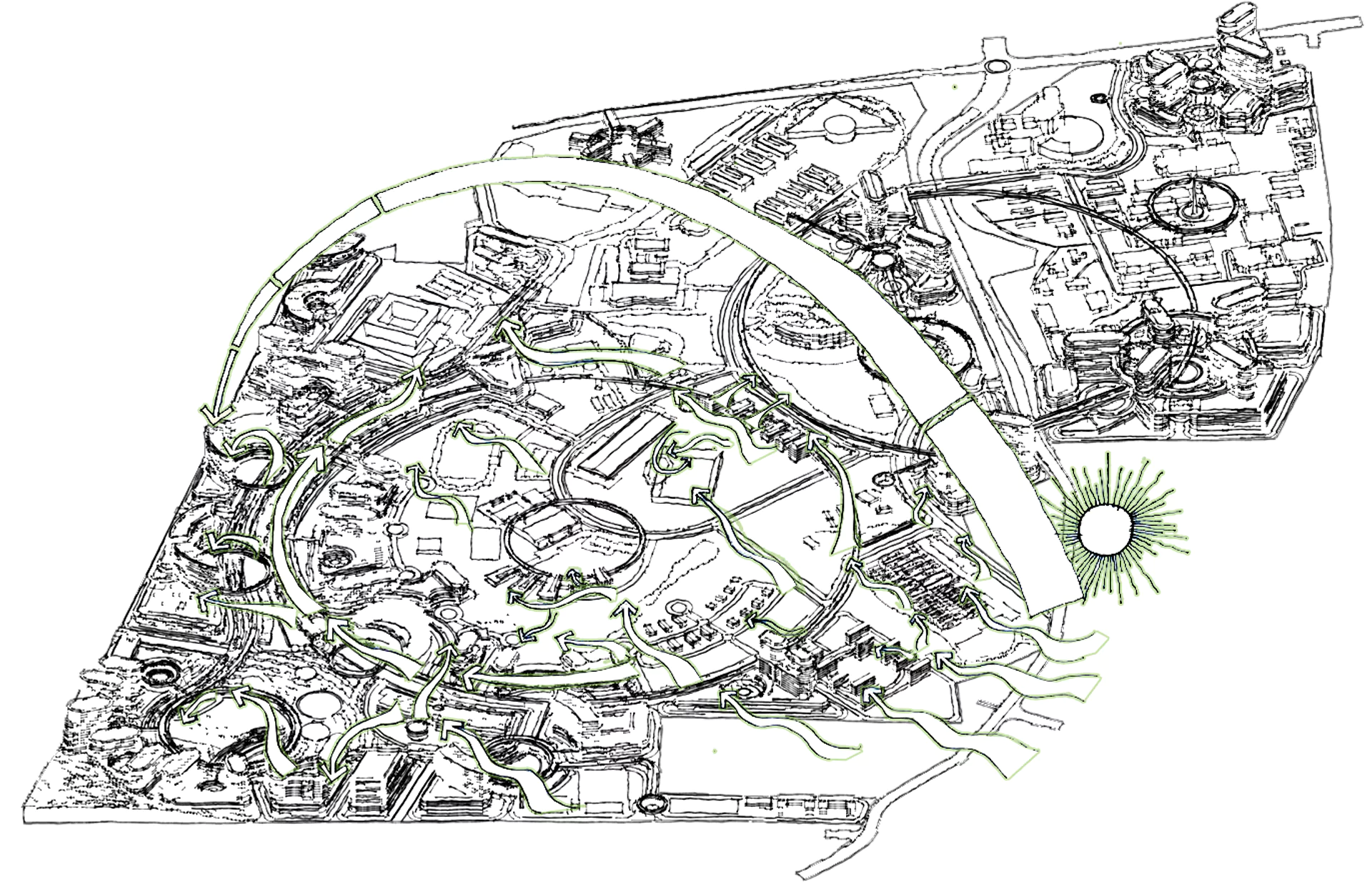As a Malaysian pioneer of ’70s bioclimatic design and ’90s intelligent energy-efficient buildings, environmental responsiveness is an essential aspect of our practice. Integrated passive-active approaches, design innovation and nature-based solutions form part of our sustainable thrust built on principles grounded in the places we make, the communities we support and the earth we live upon.

Considerations of the environment are first and foremost in any HIJJAS design approach as we explore energy, water, daylight, site and ecology intrinsic to people and planet.
Daylight — from illumination and glare to thermal radiation, shade and renewable energy — is one simple example where specific solutions can be extrapolated from a single natural element when viewed through a multifactoral design lens.
Through a thorough study of these elements of our environment, we can build a true picture of a project and its place towards achieving balanced and holistic outcomes.
Sustainable Principles

A sound environmental strategy to building does not always guarantee a 100%-responsive scheme. Constructional, behavioral and cost issues are just some of the factors that can impact sustainable ambition as we progress towards a net-zero carbon future.
At HIJJAS, we address these challenges by fleshing out the parameters of design — be it a building, a development or an entire city masterplan — that becomes an enabler of sustainable pursuit through a deep collaboration with our stakeholders and partners.
These network of blue, green and orange parameters form HIJJAS’ sustainable principles, both adaptive and responsive, that set the right level of environmental ambition while striving for sustainable excellence.
Climate Resilience

Buildings and cities of today must look to future proofing against the continual onset of climate change impact. In the tropics, water has the potential for most damage as coastal and riverine locations require adaptive measures against rising sea levels, storms and flooding. Approaches such as flood prevention and sponge cities thus become key to climate resilience.
Heat, conversely, necessitates better thermal performance in homes and buildings. Through ecosystem services, performative landscape and protection — and even new ecology — heat island effects can be mitigated in our cities.
Sustainable Material
& Resources

A consideration of all aspects of materials — from source to production to construction and ultimately landfill — must be part of contemporary design behaviour. The making of materials, lowering embodied energy and optimising their use is key to minimising the depletion of natural resources. A culture of retrofit, instead of building anew, is emerging as a better model of modern urban development.
As we continue to push for reducing resource consumption intensity, we open the door to a variety of materials such as recycled content, sustainable timber and green concrete to be used in our designs.
Restore & Value Water

Urban densification combined with rising temperatures will invariably propagate heat island growth, thus making the restoration and valuing of water a powerful climatic agent for future developments and cities.
Water bodies in masterplans become important for the movement of air; bioswales in urban parks are more than just rainwater run-off, able to harvest water for irrigation while creating beautiful landscapes that amplify liveability in the built environment.
Biodiversity & Nature-
Based Solutions

We are shifting our designs to embrace ecology as a sustainability driver. As part of a framework of ecosystem services, this means increasing green areas in a development by reducing a building’s footprint or creating green inkages between individual sites.
Biodiversity and nature-based solutions work hand in hand to improve community health and wellbeing, while strengthening local flora-fauna ecologies and countering swelling heat accrued in today’s concrete jungles.
People & Place

We approach design always with a fresh look to create places for people, new types of housing, to redefine communal densities or to invigorate workplaces and workplace connections. This experiential mindset helps bring together people and place essential to urban development and overall liveability. Through unique and bold design we create engagement that, combined with environmental sensitivity, aims to improve life-centric qualities and leave a lasting impression of a place on society at large.
Energy Solutions

Energy solutions are integral to achieving any net zero target. Yet the reality remains of energy efficiency (EE) — of at least 50% energy reduction — that comes from passive design and active systems. All-important behavioral change or energy conservation may contribute up to another 10% EE, then supported by a mix of renewable energy and conventional energy to make up 100% energy consumption. Daylight by far is the cleanest energy which we rigorously explore in our buildings, while being cognisant of glare and managing solar insolation through shade, overhangs and green roofs.
Health & Wellbeing

The 21st-century design of spaces must create a sense of health and wellbeing. We can no longer deprive ourselves of the link to nature and a retreat to quiet spaces. Intertwined social spaces, even if unused, provides the relief and respite necessary in an increasingly fast-paced world.
Exploring biophilic environments, mindful zones and communal realms, we aim to manifest accessible, flexible spaces as part of our designs. Such humanistic elements underpin an approach that has defined the delight and life embodied in HIJJAS’ architecture.
A Case Study for Future Sustainability
With its myriad educational, business and community living districts, TNB Nucleus City combines new township and legacy suburbia within a comprehensive framework of sustainable planning. Supported by IoT infrastructure, clean energy, smart mobility and nature-based solutions, the masterplan reflects HIJJAS’ sustainable principles that layer design, technology and nature to manifest a 21st-century vision of liveability and resiliency in Malaysia.









